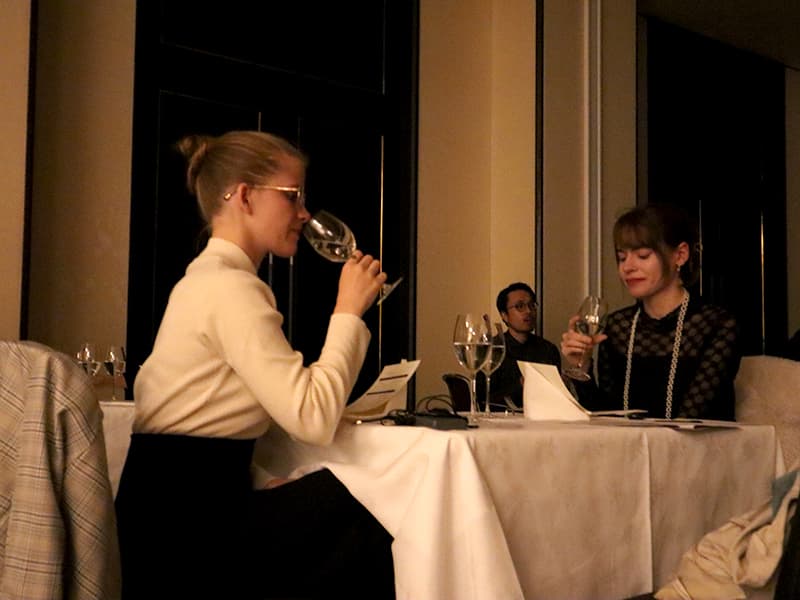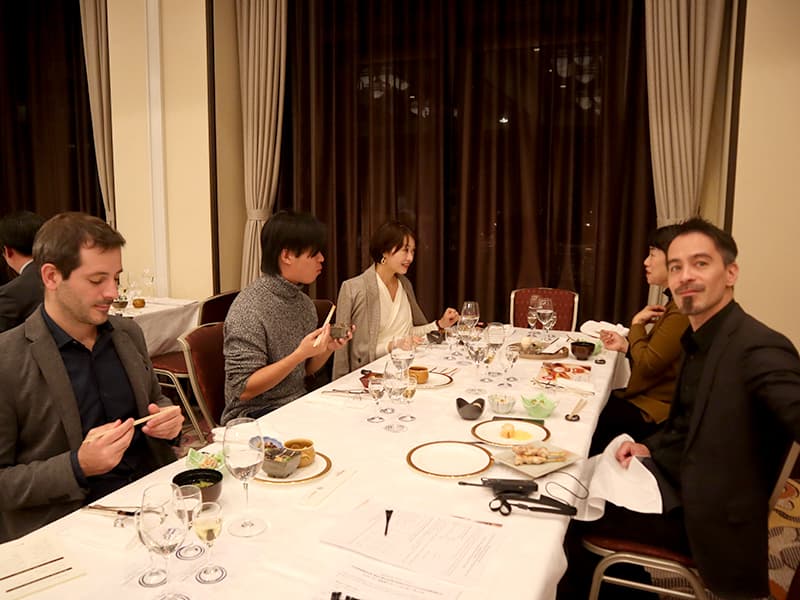In Nara, the birthplace of Japanese sake, enjoy stories about brewers and special dishes at Nara Hotel.
“Japanese cuisine is Japan’s proud food culture. Its roots are in Nara.” The “Japanese Food Pilgrimage – NARA” project plans gastronomy tourism where you can learn about the roots of Japanese food and experience the culture. Six diverse programs have started in 2023 as well.
The first event was held on October 22nd at the Nara Hotel, which was established as the “Kansai State Guest House” and has a 100-year history.
Approximately 20% of the approximately 50 guests were foreigners, and explanations of the sake on display were provided in both Japanese and English, and two simultaneous interpreter guides were on standby.

The performance began with JNO Kenichi Furuya's bassoon and Keigo Takakura's piano performances.
The special dinner began with a bassoon performance by Kenichi Furuya and a piano performance by Keigo Takakura of the Japan National Orchestra (JNO). JNO was founded by Kyohei Sorita, a world-renowned musician, and is based in Nara, transmitting music from Nara to the world.
Listening to the rich, singing tones of the bassoon and the delicate and expressive melodies of the piano, I was filled with anticipation for the special time that was about to begin.

The welcome drink is “NAON”, a Japanese sake with classical music.
Now it’s time for the long-awaited welcome drink “Naon”. “Naon” is a sake made by listening to classical music for an entire month during the fermentation process.It was served at the welcome reception of the 7th UNWTO Gastronomy Tourism World Forum held in Nara in December 2022, and received high praise. I got it.
Mr. Takahiko Toyosawa, representative of the brewery, Nara Toyosawa Sake Brewery Co., Ltd., introduced the brewery. “Although there is no scientific basis for this product, I had high hopes because just as humans find music soothing and uplifting, yeast bacteria are living organisms as well.As was well received last year, I think the product has a charming taste.” ” he greeted. While listening to bassoon and piano performances, the participants held glasses and tried the aroma and taste of “Naon,” squinting their eyes and nodding their heads.



Chairman Atsushi Kitaoka of the Nara Prefecture Sake Brewers Association explains the history of sake brewing in Nara and today's sake from the brewer.
Atsushi Kitaoka, chairman of the Nara Prefecture Sake Brewers Association, gave a speech and spoke about the history of sake brewing in Nara, the birthplace of Japanese sake, as well as “Nara sake as the sake of the past and the future.” “We would like to further promote Nara and Nara Sake as a sacred place for sake because it is Nara,” he said, and concluded by saying, “If you enjoyed today, I would like you to spread the word.”
Next, President Hitoshi Kita of Kita Sake Brewery Co., Ltd., President Dai Komai of Kikuji Brewing Co., Ltd., and Tetsuya Yoshida, manager of Imanishi Seibei Shoten Co., Ltd., spoke about today’s sake, including its origin, preparation characteristics, and taste. I gave a brief introduction.
Alcohol and food pairing lecture by Nara Hotel's Sake Diploma
Following the appetizers, buffet plates were placed on a large central table, while Nara Hotel’s sake diplomats, Makoto Inui and Minako Yoshida, explained the pairing and compatibility of today’s dishes with alcohol.
The flavor and taste of Japanese sake differs depending on the variety of sake rice, the brewing process, and the temperature at which it is served.In Nara, sake was brewed using Bodhimoto in the 15th century, and currently 10 breweries have been restored.・Explain what has been passed down.


On the day of the event, they announced that they had two types of “Beginning Sake” made with “Bodhimoto”, 5 types of “Traditional Sake” made using a method passed down from the 17th century, and 4 types of “Future Sake” made using a new method. .
For aperitifs, we use sparkling sake, for mellow flavors, we use rounded sake, for strong flavors, we use rich and sharp sake, and for dishes using soy sauce or miso, we use fermented sake. He advised that when you combine certain things, they have a synergistic effect and can make both food and alcohol even more delicious.
Marriage of hotel cuisine and alcohol Enjoy buffet style
We served a rich buffet-style meal that included plenty of local products such as Yamato vegetables, Narazuke, Yamato pork, and Miwa noodles, as well as tempura, which was fried on the spot. Guests consulted sake diplomats and brewers to select their favorite dishes and the sake that would go with them. For foreign guests, an interpreter guide provided constant support and provided easy-to-understand explanations about the characteristics of the alcoholic beverages.
When the party was in full swing, Mr. Furuya and Mr. Takakura appeared again. The song “Unknown Tears” (from Gaetano Donizetti’s Elixir of Love), which was played to “Naon”, was played and became the background music to further enliven the feast of delicious wine and gourmet food.


Enjoy the pairing of food and sake to the fullest!
Most of the guests came in pairs with their spouses or friends, but there were also four-generation families and people from the Kanto region who came alone. “Naon, it has a fruity, chocolate-like flavor.” “I tried them all (lol). Naon and ○○ were good.” “5-year-old sake, nutty like sherry.” I like it. It was even better when I had it warmed!” and “The aroma of the barrel sake was wonderful.” Some French people said, “Each sake is slightly different. You can enjoy the taste changes depending on the temperature,” and “I love wine, but it’s easier to drink than wine.” Some Japanese people are happy and say, “There are so many different kinds of sake, and you can enjoy it in so many ways! The flavors of the dishes are diverse and the taste is deeper. My image of sake has changed.” There were a lot.
“Naon” was universally popular, and people found their favorites among the other alcoholic drinks as well, and were refilled many times. After a dinner time of just over two hours, where everyone thoroughly enjoyed the delicious sake and food, we left Yamato-no-ma in a courtesy car provided by the three and five hotels.


[Starting sake]
・Kikuji Bodhimoto Junmai old sake ・Takacho Bodhimoto Junmai unfiltered raw unprocessed sake
[Traditional sake]
・Haruka Junmai Super Dry ・Okura Hinohikari Yamahai Junmai Daiginjo Unfiltered Raw Unprocessed Sake
・Yoshino cedar barrel sake ・Daiginjo Byakureki ・Gisuke special pure rice Yamada Nishiki unfiltered raw unprocessed sake
[Future sake]
・Harushika Sparkling Sake Tokimeki ・Kaze no Mori Tsuyahakaze 507 ・Daiginjo Toyosho Naon-NAON-
・Mimurosugi Dio Abita ・Uguisu no Mori plum wine
[Personal platter]
・Turban shell grilled with miso ・Narazuke and Yamato manakish ・Homemade patty with sautéed miso mushrooms
・Persimmon ham ・Scrambled eggs with caviar
[Buffet food]
・Seared bonito Yamato Tachibana ponzu jelly ・Horengusa soak and meatballs ・Seafood marinade ・Vegetable roll with pork shoulder loin ・Chirashizushi gateau style ・Shrimp frit with chili sauce ・Chicken and namul salad ・Grilled salmon wrapped in pie crust ・Braised pork from Nara ・Japanese beef shabu-shabu ・Yakitori (comparison of seasonings) ・Tempura ・Miwa noodles ・Coffee ・Japanese-style dessert
